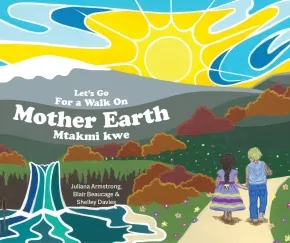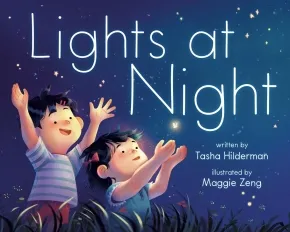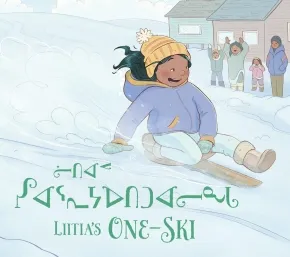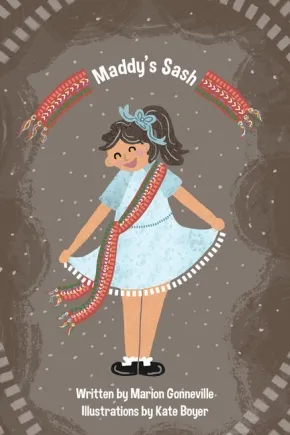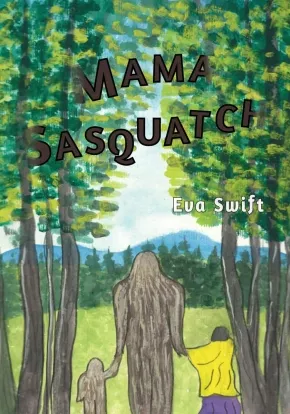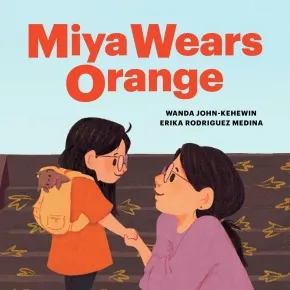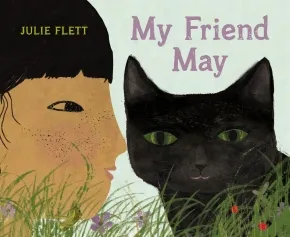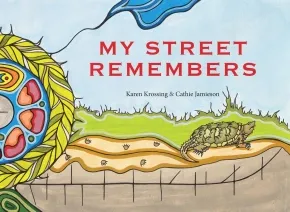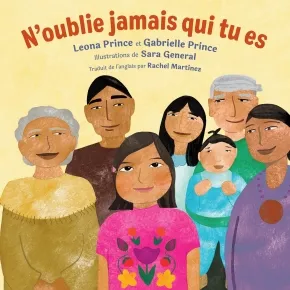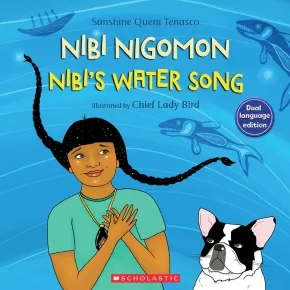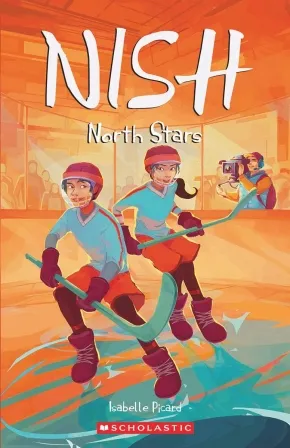
Indigenous Peoples in Canada
76
-
90
of
1317 Results;
Sort By
Go To
of 88
Les Kodiaks: L'avantage de la glace
$21.95
Format:
Paperback
Text Content Territories:
Indigenous Canadian;
ISBN / Barcode: 9782898660481
Synopsis:
Synopsis:
Tout change pour Alex Robinson. Après que son père ait accepté un nouvel emploi à Winnipeg, Alex et sa famille quittent leur communauté pour s'installer en ville. Pour la première fois de sa vie, il n’arrive pas à s’intégrer. Ses camarades de classe ne comprennent pas la culture autochtone. Même une simple marque de respect envers son professeur lui vaut des ennuis inattendus. Les choses commencent à s'améliorer lorsqu'Alex s'inscrit dans une équipe de hockey locale, les Kodiaks. Alex se révèle être l'un des meilleurs joueurs de l’équipe, mais il devient une cible parce qu'il est autochtone. Alex peut-il faire confiance à ses coéquipiers et s'opposer aux commentaires désobligeants provenant de ses adversaires? Peut-il trouver un moyen de s'intégrer tout en demeurant la personne qu’il est?
Educator Information
This book is available in English: The Kodiaks
Additional Information
Paperback
Let's Go For a Walk on Mother Earth
$22.99
Artists:
Format:
Hardcover
Text Content Territories:
Indigenous Canadian; First Nations; Anishinaabeg;
ISBN / Barcode: 9781778540653
Synopsis:
Synopsis:
Today is a good day to go for a walk on Mother Earth.
Come on a journey with young Sachiiwin and Waawaasbiikse as they count all the wonderful animals they can see. With each new animal friend, learn their Anishinaabemowin name, and discover what makes them special.
This delightful resource for little ones from Ojibway author, Juliana Armstrong, combines concepts of counting, Anishinaabemowin language learning, and traditional teachings. Accessible, repetitive and gentle, this book offers readers a space to celebrate the beauty of language, and reflect on what guides us in our own walk on Mother Earth.
Educator Information
Recommended for ages 4 to 11.
This is not a fully dual-language book, but it includes the Anishinaabemowin name for each animal in the story.
Additional Information
32 pages | 11.00" x 8.50" | Hardcover
Lights at Night
$24.99
Artists:
Format:
Hardcover
ISBN / Barcode: 9781774881149
Synopsis:
Synopsis:
In this bedtime picture book, join two special families on an illuminating journey through the year and seasons as they explore all the different lights we see at night.
It is dark . . . until street lamps turn on, one, two, three. Red light, green light, yellow light — then, suddenly, lightning strikes! Our porch light guides us home, and while we sleep, the stars of the spring sky emerge, along with new babies, their faces lit by the night. In summer, our faces shine in the campfire light while fireworks burst above us. In autumn, we shiver and cheer under the towering lights of the football field and trick-or-treat on paths lit by the flickering smiles of pumpkins. And in winter, candles and holiday lights gleam but are dwarfed by the majesty of the aurora.
This sweet, beautifully illustrated picture book, a perfect pick for introducing the seasons and seasonal activities and events, explores the simple joys we experience throughout the year when we share them with those we love.
Reviews
"A sleepy seasonal ode to the lights that shine after the sun goes down. . . . The lights, both natural and artificial, cast such warm glows that even in darker scenes, the shadows are never deep in Zeng’s peaceful, idyllic layouts. As she follows an East Asian–presenting human family and a furry four-footed one through the seasons, she tucks in grace notes, from foxlike swirls of sky mist to symbolic candles for Christmas, Kwanzaa, and Hanukkah . . . Comforting and snoozy, just right for bedtime reading." —Kirkus Reviews
"Hilderman’s evocative first-person-plural prose and Zeng’s painterly digital artwork characterize the four seasons via emblematic ‘lights at night’ in this satisfying springtide-to-wintertide tour. . . . Highlighted with the help of page-filling art and poetic lines, night lights offer an ideal and innovative angle onto the pleasures of a northern clime’s seasons." —Publishers Weekly
Educator Information
Recommended for ages 3 to 7.
Additional Information
40 pages | 10.00" x 8.00" | Hardcover
Liitia's One-Ski
$16.95
Artists:
Format:
Paperback
Text Content Territories:
Indigenous Canadian; Inuit;
Grade Levels: Preschool; Kindergarten;
ISBN / Barcode: 9781774508091
Synopsis:
Synopsis:
Liitia can't wait to compete in the one-ski race, but she will need practice and a little help if she wants to win!
Liitia lives in Qausuittuq (Resolute Bay), Nunavut, where there is a one-ski race at the end of each spring. Liitia's grandma was always the fastest racer when she was a child, and Liitia wants to race too! She is determined to win the race at the end of the season, even with her old rusty one-ski. Join Liitia in this bilingual picture book as she prepares for the race with a little help from her Grandma.
Reviews
"Ideal for shared reading in K–1 classrooms, the book supports curricular connections in Social Studies and Physical and Health Education. In Social Studies, it encourages exploration of how children live, play, and celebrate across different regions of Canada. In Physical and Health Education, it supports discussions of winter sports, seasonal physical activity, and outdoor play in diverse climates." - Bonny-Lynn D., Elementary School Teacher, Indigenous Books for Schools
Educator & Series Information
Recommended for ages 3 to 5.
Liitia’s One-Ski is about a young girl in Resolute Bay, Nunavut, who wants to race in a community one-ski competition. The story is inspired by a real championship that took place and the author’s memories of one-skiing while growing up in Resolute Bay.
In this story, Liitia learns the importance of trying your best and not giving up when faced with challenges as she works toward her dream. This story also demonstrates the value of good sportsmanship and supporting each other as the competition brings people together.
This bilingual storybook is part of our Community Connections series, which is a collection of fun and engaging stories from Inuit authors that celebrate Nunavut communities.
Dual-language: English and Inuktitut
This title is included in the Indigenous Books for Schools database from the Association of Book Publishers of BC as a recommended resource for K to 1 for Social Studies and Physical and Health Education.
Additional Information
27 pages | 8.00" x 10.00" | Paperback
Little Shoes
$24.99
Format:
Hardcover
Text Content Territories:
Indigenous Canadian; First Nations; Cree (Nehiyawak);
ISBN / Barcode: 9781774881729
Synopsis:
Synopsis:
From the bestselling and Governor General's Award–winning author of On the Trapline comes a beautifully told and comforting picture book about a boy's journey to overcome generational trauma of residential schools.
Deep in the night, when James should be sleeping, he tosses and turns. He thinks about big questions, like why we don't feel dizzy when the Earth spins. He looks at the stars outside his bedroom and thinks about the night sky stories his kōkom has told him. He imagines being a moshom himself. On nights like these, he follows the moonlit path to his mother's bedroom. They talk and they cuddle, and they fall asleep just like that.
One day, James's kōkom takes him on a special walk with a big group of people. It's called a march, and it ends in front of a big pile of things: teddy bears, flowers, tobacco ties and little shoes. Kōkom tells him that this is a memorial in honor of Indigenous children who had gone to residential schools and boarding schools but didn't come home. He learns that his kōkom was sent away to one of these schools with her sister, who also didn't come home.
That night, James can't sleep so he follows the moonlit path to his mother. She explains to James that at residential school when Kōkom felt alone, she had her sister to cuddle, just like they do. And James falls asleep gathered in his mother's arms.
Includes an author note discussing the inspiration for the book.
Reviews
"Robertson (Norway House Cree Nation) sensitively approaches this history, never explicitly describing the horrors of residential schools but instead leaving space for adults to grapple with youngsters’ questions in their own ways. Though he doesn’t provide easy answers, it’s clear that familial love keeps this child buoyed. Suffused with pinks, icy blues, and deep indigos, the glowing, cartoon-style digital illustrations from McKibbin (Ojibwe) depict the ancestral bonds that keep James rooted. Honest yet age-appropriate and deeply uplifting." —Kirkus Reviews
"Cree author Robertson reteams with Ojibwe, Yoeme, and Irish artist McKibbin (The Song That Called Them Home) for this work that honors children who did not return from residential schools. . . . James and his mother’s musing on intergenerational story-sharing further contribute to themes of connection and loss in this emotional work." —Publishers Weekly
"[Robertson and McKibbin] have taken on the weighty task of presenting a catastrophic loss to young readers, but also offering hope and determination. With poetic text and images of family life that are both familiar and mystical in tone, they have achieved this goal. . . . The honesty of Little Shoes is an antidote to fear." —Imaginary Elevators
"[A] big story about generational trauma of residential schools [which] focuses on the comfort that comes from family. Maya McKibbin evokes comfort and discomfort, as well as affection and thoughtfulness, with great sensitivity. . . . [A] great discussion starter for families and classes about residential schools, about Every Child Matters, and about asking questions. But it will also inspire understanding and empathy for that which has happened so that tragedies like residential schools are not repeated." —CanLit for Little Canadians
Educator Information
Recommended for ages 3 to 7.
This book is available in French: Petits souliers
Additional Information
48 pages | 8.00" x 12.00" | Hardcover
Maddy's Sash
$17.50
Artists:
Format:
Hardcover
Text Content Territories:
Indigenous Canadian; Métis;
ISBN / Barcode: 978-1-988011-35-6
Synopsis:
Synopsis:
Maddy’s Sash, by Marion Gonneville, with illustrations by Kate Boyer, is the story of a young girl who connects with her Métis roots while she spends time with her Moshôm, Kohkom and their special dog Max. Maddy has many adventures at her grandparents’ farm in northern Saskatchewan, including an exciting berry picking adventure, a dramatic canoe trip, and a rollicking barn dance.
Reviews
"Maddy’s Sash is a wonderful read-aloud for classrooms, especially when exploring Métis culture and heritage. When Maddy visits her moshôm and kôhkom (her grandpa and grandma), she learns about her family’s roots by joining in cultural activities that are part of their daily life. Maddy bonds with a big Newfoundland dog named Max and helps care for a newborn chick on the farm. As the visit unfolds, she makes new friends and takes part in a traditional Métis barn dance, where she learns to jig with the guidance of her grandparents. This heartwarming story celebrates the joy of simple living, the importance of caring for others, and the richness of Métis traditions. It’s an ideal read for students in grades 2-5." - Debra H., Elementary School Teacher, Indigenous Books for Schools
Educator Information
Chapter book.
This title is included in the Indigenous Books for Schools database from the Association of Book Publishers of BC. It is recommended for Grades 2 to 5 for English Language Arts, Dance, and Social Studies.
Additional Information
10 Chapters: 88 pages | Hardcover
Mama Sasquatch (French)
$18.95
Format:
Paperback
Text Content Territories:
Indigenous Canadian; First Nations; Nuu-chah-nulth (Nootka); Ditidaht First Nation;
ISBN / Barcode: 9781068868610
Synopsis:
Synopsis:
A la recherche de buissons de baies, Nala se perd, seule dans la forêt ! Heureusement, Mama Sasquatch entend ses cris et veille sur elle toute la nuit. Le lendemain, Nala apprend comment et pourquoi Mama et Bébé Sasquatch vivent dans la forêt, loin des gens.
Une histoire à la fois charmante et apaisante pour les jeunes enfants, Mama Sasquatch présente des illustrations peintes envoutantes de l?artiste et autrice Eva Swift, de la nation Ditidaht.
Educator Information
Recommended for Grades 3 and under.
This book is available in English: Mama Sasquatch.
Additional Information
7.00" x 10.00" | Paperback
Miya Wears Orange
$21.95
Artists:
Format:
Hardcover
Text Content Territories:
Indigenous Canadian; First Nations; Cree (Nehiyawak);
ISBN / Barcode: 9781774921258
Synopsis:
Synopsis:
A beautifully illustrated book that gently explores the complicated feelings a young girl experiences as she learns about tragedy and injustice.
Miya loves her school and she especially loves storytime. One day, her teacher shares a story about a little girl who was taken away to a residential school. The little girl wasn’t allowed to go home. Her hair was cut and she wasn’t allowed to keep her favourite doll. She was taken away from her family because she was Indigenous, just like Miya!
Miya worries the same thing will happen to her. Her mom tells her that Indigenous girls and boys aren’t forced to leave their families anymore. Miya is relieved, but she is still sad. What can she do about these feelings?
Reviews
"A moving and important story that deftly explores the fear a little Indigenous girl feels when she learns the truth about residential schools. Miya finds solace in her mom’s words, and readers will too. A sensitive explanation of residential schools that prioritizes the emotional safety of all readers, especially Indigenous children."— Jen Moss, lecturer at UBC's School of Creative Writing
"opens the door to an important discussion about residential schools" - School Library Journal
Educator Information
Recommended for ages 6 to 8.
In this story, a young girl named Miya feels scared and sad after learning about residential schools, but she learns how to cope with the help of her mother.
A gentle story about big feelings and finding courage.
Big Ideas: Social-Emotional Learning: Emotions and Feelings; Social Justice: Intergenerational Trauma, Residential Schools.
This book is available in French: Le Chandail orange de Miya.
Additional Information
40 pages | 8.50" x 8.50" | Hardcover
Mother Earth: My Favourite Artist
$22.99
Artists:
Format:
Hardcover
Text Content Territories:
Indigenous Canadian; First Nations; Cree (Nehiyawak);
ISBN / Barcode: 9781778540615
Synopsis:
Synopsis:
Have you ever considered Mother Earth to be an artist? A shiny rock, the guiding tracks of a bird, a colourful sunset - what beauty do you see on Mother Earth?
Award-winning Indigenous author, CBC journalist, and Poet Laureate of Saskatchewan (2021-2023) Carol Rose GoldenEagle brings readers a radiant tribute to the artwork within the everyday. Paired with stunning illustrations by Hawlii Pichette, Mother Earth: My Favourite Artist encourages us to share in the simple wonder of nature, and honour the precious magnificence of Mother Earth and all of our relatives.
Educator Information
Recommended for ages 5+.
A teacher lesson plan is available: Mother Earth: My Favourite Artist Teacher Lesson Plan
Additional Information
28 pages | 11.00" x 8.50" | Hardcover
My Friend May
$23.95
Artists:
Format:
Hardcover
Text Content Territories:
Indigenous Canadian; First Nations; Cree (Nehiyawak);
ISBN / Barcode: 9781778401718
Synopsis:
Synopsis:
From the winner of the New York Times Best Illustrated Book Prize and the American Indian Youth Literature Award
I’d like to tell you a rather true story about a big black cat who started out gray. Her name was May.
Margaux and her cat May became friends when Margaux was just six years old. They grew up together, sharing countless memories along the way. But one day, May is late coming home. Where is May? Is she under the porch? Maybe on the roof?
Margaux’s nitôsis (the Cree word for auntie) helps search for May in the tall grass. But soon nitôsis needs to leave: she’s moving away to the big city, and has to pack her things into boxes. Margaux helps nitôsis, but she can’t take her mind off May. Will she ever return? nitôsis is worried, too. But little do they know, May has a surprise in store for both of them!
This fun and heartwarming story with a surprise happy ending invites readers to share their own cat stories. My Friend May is a tribute to love and the balance between all beings, and the experiences and emotions that connect us all.
My Friend May features:
- A glossary of Cree words used throughout the book
- Backmatter content that includes a pronunciation guide
Reviews
"A quiet yet affectionate tribute to familial relationships of all stripes….Cat lovers… will particularly enjoy this sweet tale."—Kirkus Reviews
"From a talented picture book creator….Readers can reflect on great stories of their own encounters with beloved animal friends and share their tales with others….delightful.”—School Library Journal
"Award-winning author Julie Flett has created another beautiful story, perfect for read-alouds in kindergarten to grade three classrooms.... This heartwarming tale gently explores themes of love, loss, and reunion. With Flett’s signature artwork and tender storytelling, My Friend May will resonate with readers of all ages and spark connections to their own stories of friendship and change." - Debra H., Elementary School Teacher, Indigenous Books for Schools
Educator Information
Recommended for ages 4 to 8.
This title is included in the Indigenous Books for Schools database from the Association of Book Publishers of BC as a recommended resource for K to 3 English Language Arts.
Additional Information
40 pages | 11.00" x 9.00" | Hardcover
My Street Remembers
$21.99
Format:
Hardcover
Text Content Territories:
Indigenous Canadian;
ISBN / Barcode: 9781773066356
Synopsis:
Synopsis:
How many footsteps have walked your street in the past? My Street Remembers peels back the history of one city street in North America to reveal the greater story of the land on which we live.
The story begins 14,000 years ago, when mammoths roamed the icefields, and the First Peoples followed their trail. Historically accurate illustrations show the lives of their descendants over thousands of years as they hunted and gathered food, built homes and celebrated together, until the 1600s, when Europeans arrived with settlers in their wake.
In lyrical text, the street remembers agreements to live in peace, the efforts of the British to take the land with unfair treaties, and the conflict and suffering that followed. The street recalls its naming, paving and the waves of immigrants who called it home. Illustrations of recent times depict Canada's apology to Indigenous Peoples and efforts toward Truth and Reconciliation, including a march with a banner that reads: Every Child Matters.
This rich collaboration between author Karen Krossing, of White settler descent, and Anishinaabe artist Cathie Jamieson ends with a question that readers anywhere can ask-what does your street remember?
Reviews
"A thoughtful overview and reflection on the life and legacy of a busy street." — Booklist
Educator Information
Recommended for ages 3 to 6.
This book is part of the Better Path series.
Reading Levels: Lexile NC940L
Key Text Features:
- author's note
- bibliography
- captions
- explanation
- facts
- flags
- further information
- historical context
- historical note
- illustrations
- illustrator's notes
- sources
- timeline
- vignettes
- writing inspiration
Correlates to the Common Core State Standards in English Language Arts:
CCSS.ELA-LITERACY.RL.1.3
Describe characters, settings, and major events in a story, using key details.
Additional Information
48 pages | 11.00" x 8.00" | Hardcover
My Visit to Kimmirut
$16.95
Artists:
Format:
Paperback
Text Content Territories:
Indigenous Canadian; Inuit;
Grade Levels: Preschool; Kindergarten;
ISBN / Barcode: 9781774508060
Synopsis:
Synopsis:
What will Monica see and learn when she visits a new community?
Monica is visiting her aunt Peesee in Kimmirut, Nunavut. There are many wonderful things to see and do there. Monica is excited to explore and learn about her aunt's community. Join Monica and Peesee as they go clam digging, visit waterfalls, and see the tallest trees on Baffin Island in this bilingual picture book!
Reviews
"In the story, Monica shares about visiting her aunt in Kimmirut. At the beginning of the story, she explains that the village was renamed with its traditional name (Kimmirut) from its settler name (Lake Harbour). Different cultural elements are explored: resources, arts, food, activities, and land features. As well, there is an exploration of the seasons through images, contrasting the end of summer and winter. Teachers can point out to the students that with the exception of two pages, there are no trees on the landscape. This would be a good introduction to biomes and an inquiry into the arctic tundra. While the book is written for younger students, older students could benefit from the story and extend their learning by engaging in an inquiry project about the traditional Inuktitut names that are increasingly used in Nunavut in an effort to decolonize place names. For instance, Baffin Island’s traditional Inuktitut name is Qikiqtaaluk." - Alethea S., Indigenous Books for Schools
Educator & Series Information
Recommended for ages 3 to 5.
Dual-language: English and Inuktitut
This book is part of the Community Connections series.
This title is included in the Indigenous Books for Schools database from the Association of Book Publishers of BC, recommended for K-5 English Language Arts and Social Studies.
Additional Information
23 pages | 8.00" x 9.00" | Paperback
N'oublie jamais qui tu es
$21.95
Format:
Hardcover
Text Content Territories:
Indigenous Canadian; First Nations; Dene; Dakelh (Carrier); Lake Babine Nation ; Nak’azdli Whut’en; Beaver Clan (Lhts'umusuyoo);
Grade Levels: Preschool; Kindergarten;
ISBN / Barcode: 9781459841772
Synopsis:
Synopsis:
Tu as plus de pouvoir que tu le crois.
Ce livre aux illustrations lyriques parle aux jeunes de leurs racines culturelles, de la sagesse de leurs ancêtres et de leur propre potentiel. Chaque page propose une affirmation sur l’identité, le respect, l’amour et la vérité, encourageant tous les enfants à accepter leurs dons et leur pouvoir uniques. En abordant la résilience qui coule dans leurs veines et les savoirs inscrits dans le ciel, N’oublie pas qui tu es inspire les enfants à se considérer comme des membres à part entière de leur communauté, comme des personnes capables à la fois d’un grand leadership et d’une grande gentillesse.
Parfait pour la lecture à l’heure du coucher et les discussions en classe, l’album favorise un profond sentiment d’appartenance et de fierté en célébrant l’héritage autochtone et en rappelant aux jeunes lecteurs qui ils sont vraiment. Également disponible sous le titre Remember Who You Are en anglais.
Educator Information
Recommended for ages 3 to 5.
This book is available in English: Remember Who You Are.
This book is available in a dual-language format: Remember Who You Are / kiskisi awîna kiya.
Additional Information
32 pages | 9.00" x 9.00" | Hardcover
Nibi nigomon/Nibi's Water Song
$8.99
Format:
Paperback
Text Content Territories:
Indigenous Canadian; First Nations; Anishinaabeg;
ISBN / Barcode: 9781039700673
Synopsis:
Synopsis:
Nibi is determined to bring clean water to her community.
Nibi is the Anishinabemowin word for water. In Nibi’s Water Song, Nibi is an Indigenous girl on the search for clean water to drink. Though she is faced with repeated obstacles, Nibi’s joyful and determined energy becomes a catalyst for change and action as her community rallies around her to make clean drinking water available for all.
First published in 2020, Nibi’s Water Song was shortlisted for both the IODE Jean Throop Award and longlisted for the First Nations Communities READ Award. This dual-language edition presents the text in both English and Anishinabemowin.
Educator Information
Recommended for ages 4-8.
Dual-language: English and Anishinabemowin
Translated by Tina Nottaway. Tina is an Algonquin Anicinabe Ikwe artist and translator from Rapid Lake, Quebec. She is fluent in her language, Anicinabemowin. Tina is also a crafter and facilitates workshops on moccasin making, birchbark basket making and other cultural activities.
This resource is available in English: Nibi's Water Song
This resource is also available in French: Nibi a soif, très soif
Additional Information
32 pages | 9.51" x 9.51" | Paperback
Nish: North Stars
$14.99
Text Content Territories:
Indigenous Canadian; First Nations; Innu (Montagnais-Naskapi);
ISBN / Barcode: 9781039710818
Synopsis:
Synopsis:
Lights. Cameras. Hockey!
The school year is finally over and Eloise and Leon are back in Matimekush for the summer. But this school break will not be like any other, thanks to a hockey movie being filmed in the community! Is it possible that Leon will be in the movie? Will Eloise, who is interested in directing, participate in the project? Summer will be busy with twists and turns of all kinds for Leon, Eloise and their friends. It's the summer of possibilities!
Educator & Series Information
Recommended for ages 10 to 14.
Translated by Kateria Aubin Dubois, a freelance translator and a prolific beadworker. Her beadwork can be found under her Indigenous name, Nisnipawset. Kateri is from the Wolastoqiyik Wahsipekuk First Nation. She lives with her husband, two children and a fluffy cat in Terrebonne, Quebec.
This is the third book in the Nish series.
Additional Information
240 pages | 5.00" x 7.75" | Paperback
Sort By
Go To
of 88




